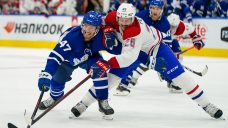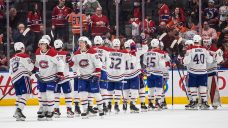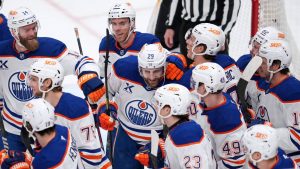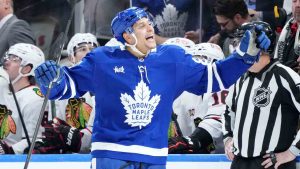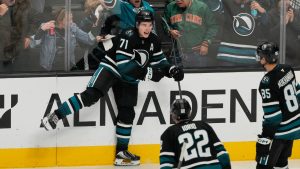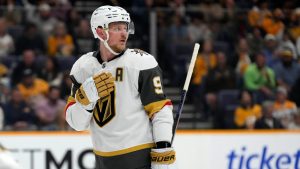VANCOUVER -- Kent Hughes sends out texts to two rival general managers to let them know he’ll be unavailable for the next 25 minutes. He’s sitting in a secluded wing on the third floor of the harbour-side Vancouver hotel the Montreal Canadiens are staying at, graciously waiting to appease my request for an interview he said he’d prefer not to do.
“I have no issue with transparency, though I can’t be transparent with everything. And I’m happy to be accessible. But you’ll understand I’m not going to give you our playbook for the trade deadline,” Hughes starts. “And I’ve done so many interviews, and (coach) Marty (St. Louis) has done so man -- I don’t want people thinking it’s all about us. It has to be about the players. They’re the ones going out there and winning these games, and they deserve for the attention to be on them.”
He’s right, of course. There’s a lot to say about Nick Suzuki, who appears to be taking his game from atmosphere to stratosphere here in these final months before his eight-year, $63-million contract kicks in and pays him to join the other stars in the mesosphere. And then there’s Cole Caufield, the prohibitive favourite for rookie-of-the-year honours who stumbled with just one goal and seven points through his first 30 games and now has seven goals and 14 points over his last 11.
Laurent Dauphin and Rem Pitlick are emerging as capable NHL players, Brett Kulak is playing the best hockey of his career, goaltender Samuel Montembeault is taking advantage of the best opportunity he’s had since he was drafted 77th overall by the Florida Panthers in 2015, and undrafted defenceman Corey Schueneman is proving he can be a reliable depth option at this level.
Back at the top end, Mike Hoffman has found his best self of late, not only producing two goals and five points in wins over the Calgary Flames and Edmonton Oilers but continuing to show he can move south just as well as he does north. As a result, St. Louis has been praising his defensive game and doing much to break him free of his reputation of being a one-dimensional player.
Josh Anderson has scored six of his 15 goals on the season for his new coach, and Brendan Gallagher has finally shed the proverbial monkey from his back (it probably felt more like a silverback gorilla considering he hadn’t scored in 18 games before finally bagging one in his hometown of Edmonton) and has appeared much more like the Gallagher we’re all used to seeing.
I tell Hughes I’d also like to speak him about what the future holds for him with big roster decisions looming between now and the March 21 trade deadline -- and beyond.
“I don’t really have a lot to say about Gally,” Hughes responds about the winger who’s in Year 1 of a six-year, $39-million contract that comes with a modified no-trade clause and a no-movement clause. “He’s been a great contributor to this organization for a long time, and he’s on a long-term deal. He works his butt off.
“He’s been pretty impactful on this road trip. When you watch him, he’s missed a couple of great chances, which always happens when you’re snake-bitten. But he’s averaged close to 30 goals a year in his career. He missed one in Edmonton -- I don’t know if you saw -- where there was a rebound right there and it just popped over his stick. When you’re not having puck luck, that happens. Then he ended up scoring that game. Cole Caufield went however many games (without scoring). We can say it’s all (former coach) Dom (Ducharme), but there’s also a component of you start feeling good about yourself and all of a sudden you start scoring goals. So, hopefully the same will happen with Brendan Gallagher, who’s a pretty important player to this organization.”
There are others who will stay, too, as Hughes insists he and Canadiens executive vice president of hockey operations Jeff Gorton have no intention of ripping this roster completely apart and starting over from scratch.
Still, the deadline looms and Hughes has much more on his plate than just trying to extrapolate the best return for Ben Chiarot and one that makes sense for Jeff Petry. What follows is a transcript of our conversation about what lies ahead immediately for the Canadiens, but also about St. Louis’ work and his future, about a recent hire in player development, about plans to expand hockey operations in development, analytics and scouting, about philosophies and blueprints, and definitely about his players. You’ll note Hughes is wisely evasive and purposefully vague where he needs to be, but he still had much of intrigue to say before running off to a meeting.
There are a few very minor edits in here, purely for clarity and brevity.
Eric Engels: How do you balance what you saw when you first arrived close to two months ago versus what you’re seeing in this short sample of winning hockey?
Kent Hughes: I think dating back to the first press conference, if you recall what I said about scouting, it was familiarity is important. The longer you have eyes on players and different situations, the better understanding you get of a player. That applies to your own team, as well; it’s not unique to going to scout amateur hockey players.
We’ve seen guys who weren’t performing well who are performing very well now. Part of that will always be confidence and situational. But part of it also might be style of play. There are players who are going to excel playing the game a certain -- Marty refers to brand -- I would call it style of play. I think we’re both meaning the same thing, with different descriptions. But that’s relevant.
EE: Is this the style of play you want to see?
KH: Yeah. I think we talked about it from the beginning in terms of playing a faster brand of hockey and a puck-possession brand of hockey.
EE: So, is there more value, as you make your plans for the deadline, in that shorter sample than there normally would be -- being able to evaluate your players within the brand/style of hockey you want to play moving forward?
KH: Yeah. But I still think Rome wasn’t built in a night. We don’t need to have everything figured out now. There are certain things that are time-specific because of the trade deadline, and then there’s a lot of other things that we have time to look and understand and evaluate what we have.
EE: What’s the market like now, with the trade deadline finally in view?
KH: I think every team has different considerations. We were able to figure something out and get (the Tyler Toffoli) trade done. We did Andrew Hammond, too, but I would say one was a more significant trade in terms of Tyler. I look at it as teams will come at it from different perspectives.
First of all, in the Western Conference things are so close and I’d imagine -- I don’t know -- there’s teams that if you’re on the fringe and you don’t know, then what are you doing? Are you making the push to get in? Or are you not getting in and risking giving away some component of your future? I think there’s others that will look at it and say, ‘We’re really good, we’ve got to invest more.’ It’s going to be a case-by-case situation. But there’s a lot of good hockey teams in the NHL this year.
EE: Is the chatter picking up?
KH: I think it’s been pretty continuous, to be honest with you.
EE: What’s the interaction been like? I know it’s not your first time dealing with GMs, but this is a different context.
KH: Different context, but it’s similar. When we’d go into free agency -- especially in those years where there was the interview period -- it’s conversations and feeling each other out. The process that went into it is you’d go on for a week and try to gauge where teams are, so this is kind of the same thing.
EE: There’s been a lot of reported interest in Ben Chiarot. You said previously, you’d move him when you get what you’re looking for. Are people trying to squeeze you on that as we approach the deadline?
KH: I don’t think people are trying to squeeze us. Again, if I look back (at his own experience as an agent in free agency), there’s a lot of exploring that goes into this type of process. I’m guessing teams are trying to understand what the cost of Chiarot is versus another potential option and they’re going to make their decisions. Conversely, we would look and compare different options of what fits best for us.
EE: How do you view Artturi Lehkonen’s situation—a pending RFA who’s a year away from UFA, a valuable player to your team but also on deck for a contract that could crowd your bottom-six forward group with another pricey player if you keep him?
KH: We’re not trying to trade him right now. I think I’ve said that about a number of players on our team. We’re not trying to trade them, but that doesn’t mean we wouldn’t receive phone calls with regards to them. And if something happens…
We weren’t specifically trying to trade Tyler Toffoli, either; it just materialized, through a conversation, with a deal we thought made sense for us and Calgary thought made sense for them.
I think I said it before; we’re not looking to do a fire sale here. And the more time we have to evaluate our group and make intelligent decisions, the better off we are.
EE: Are you trying to trade Shea Weber?
KH: Are we trying to trade him? No. We’ve had phone calls. There’s a lot of speculation and rumours.
I’ve read all kinds of things of we have scouts in different buildings. If they are, I’m not aware of it. There’s probably a lot out there that’s not necessarily accurate.
EE: You’re saying you don’t need to figure everything out right away, and you’re also saying you’re not necessarily actively trying to trade anyone and that you’ll take calls and make decisions as they come along. Some people might wonder if you guys have a plan. Obviously, you do, but how rigid is it?
KH: I think I said this before, that in the course of rebui…not rebuilding but whatever term you’d like to give it…
EE: Do you dislike that term?
KH: I just don’t believe in the term. People can associate a certain thing with a rebuild versus a reset or a retool; I think Doug Wilson was the first guy to use a different term. Reset is what I think he was using. My objective is to try to build a roster that’s going to include players who are here and it’s going to include new players coming in. But hopefully we’re going to put a team on the ice that can win on a sustainable basis. So, if a rebuild means we’re stripping everything down and trading everybody away, then no, I don’t believe we’re doing that.
But you can create a blueprint and say, “This is how we’re going to do it and this is Step 1, 2, 3 and 4,” and actually believe that everything goes according to plan, but I just think there’s a natural component of having to react to certain circumstances along the way. It’s just too hard to predict injuries and lack of performance from someone you expect to do something and doesn’t or somebody who steps in and ends up being way better than you anticipated. So, there’s a certain component of flexibility required.
EE: Like Mike Tyson said, everyone has a plan until you get punched in the face.
KH: Right. And again, the timing of it is important. More information you have, the better. And like I’ve said before, we’ll trade Ben Chiarot, but we’re not trading everybody.
EE: On the theme of whatever R-word you’d like to use for this project, a lot of fans got their backs up when it was reported you’d be active in free agency. You’ve said all along that you valued players like Mark Recchi for the 2011 Cup-winning Bruins and Tim Taylor and Dave Andreychuk for the 2004 Cup-winning Lightning back in the day, so are we looking more at those types of acquisitions? Or are you going for the biggest fish in the sea?
KH: I don’t see us going after the biggest fish in the sea in free agency. If we’re talking about a (seven-year) max contract, I don’t think that’s what we’re looking to do here. But we’ll go into free agency with the objective of trying to accomplish certain things with our team that are going to match our overall plan.
EE: With the deadline looming, have you had any contract discussions with some of your pending unrestricted free agents who you may want to keep?
KH: I’m not prepared to talk about contracts with you. I can’t answer that.
EE: Understood. Where are things at with Carey Price?
KH: I’ll leave that to our medical people to answer.
EE: Is it still possible he’ll play this season?
KH: Yep.
EE: How do you view your goaltending situation in general, with Jake Allen, Sam Montembeault and Hammond? Is it more important to hold on to all of them with the uncertainty Price is facing?
KH: We have all those players. They’re here and under contract for the year. And Carey Price -- we’re waiting and watching to see what we’ll happen with him.
EE: Is there a possibility of adding players before this deadline -- in hockey deals, and not just taking back expiring contracts?
KH: If you’re asking if a trade would only necessarily involve a draft pick coming back, we’re going to be open and flexible to other things.
EE: Would it be accurate to say there’s more interest in prospects coming back than picks? And if so, why is that potentially more valuable to you?
KH: Timing and information. If somebody’s two years older, two years post-draft, you have more information on that player. It’s easier to predict what you’ll get out of a 20-year-old than an 18-year-old, easier to predict an 18-year-old than a 16-year-old.
That doesn’t mean we don’t want draft picks. We’re going to look at anything, including former picks who are already playing.
EE: What do you make of people saying this upcoming draft isn’t very deep?
KH: I think most people think it’s a deep draft at the very top end of it. My guess is there’s going to be really great players in this draft who go on to great careers in the NHL. It doesn’t always mean it’s the player that’s projected to do it, but we’ve seen that year-in and year-out.
Look at Shea Weber as a second-round pick (at 49th), and Patrice Bergeron was right before him at 45. It was an incredible draft (in 2003), and those two may have been the best players in it.
EE: Has the deadline coming pushed back the process for other things like hiring another assistant GM?
KH: Yes. Not just that; we wanted to get the player development piece started. I wouldn’t say it’s done, but at least it’s started. And I think that’s important as we go into a draft. And we’ve got a number of picks this year, so it’s important that we’ve got a group in place to work with at least part of our future of our organization. But it’s also working with our whole organization. I don’t believe our development group will strictly work with prospects, but also with the players in Laval and in Montreal.
EE: Why Adam Nicholas (the new director of hockey development)?
KH: Well, some people think of skills coaches, but I see him differently. He’s more of a development coach than just a skills coach. He’s somebody that’s going to work really with our coaching staff, and we’re going to be aligned and we’re going to develop plans to develop hockey players. I’ve talked to Adam a lot about hockey. He’s had different experience with a couple of organizations -- Chicago Steel being one of them, the Toronto Maple Leafs another -- who I think have invested pretty significantly in their player development. First and foremost, I believe in his hockey acumen and his ideas and his ability to help. He’s worked with a lot of our NHL players (his former clients with Quartexx), he’s worked with my kids (sons playing for the Northeastern Univerisity), so I’ve used him and been a consumer. I think he’s going to do a great job.
EE: Is he bringing anybody with him?
KH: He’s not bringing anybody with him, but (there will be more). Again, this job (as GM), it’s only been two months. You take the job, then you go on the road, then we have our pro meetings, so we’ve got all these ideas of everything we want to do but the day-to-day makes it so we have to push things off here or there. And it’s also that the longer I’m on the job, the more I’m learning, and the more I’m able to say, “We need this, or we need that.” I don’t want to just come in and say, “I’ve already got everything figured out and this is what we’re doing.” I think as we go along and go through it, we’ll figure out where we have shortcomings and what sort of skillsets we really need. I don’t really care about titles. I’m not saying I need another assistant GM or this or that, I want to look at it and say, “This is a need that we have, and this is the type of skillset we need to fill that type of role.
EE: How expansive do you see that staff becoming?
KH: Not sure. It won’t happen all at once. If we do it all at once and get it wrong, we’re going to be anchored down. I want to start this process, get a proper feel, get feedback. Ultimately, I see our development people working with our analytics people, everybody kind of working together. I’ve talked about it a lot—more of having this circular experience among hockey ops instead of these different silos. And in order for that to happen, there’s a feeling out process too.
As far as the analytics piece is concerned -- and I saw (AGM John Sedgwick) Sedgy called it information, and I call it analytics but ultimately it’s data -- it’s looking at data and saying, 'How can data help us.' That’s not unique to us as the management group deciding; I think it’s our coaching staff and finding out what kind of data they want. And it’s about what do you know? And what can you learn once you have the data?
And it’s the same thing on the player development side, and I’m sure the sports performance side too, saying, “What kind of data do you guys need? And what are you able to garner on your own? And how can we create an information system that would give you more? And how do we just become a more cohesive hockey operations organization?”
EE: How close are you on analytics? Know you met a lot of people.
KH: We met a lot of people. Again, I think the day-to-day of trade deadline and the team have probably delayed things a little bit and I was stuck in the US for a little bit. I had COVID, so I got caught for 10-11 days. Just couldn’t get back across the border.
As far as the plan, I always believe in being flexible to begin with. And even with the plan going into the trade deadline there’s at least some flexibility in terms of what we do. We have certain things that we want to accomplish, and not everything’s going to get accomplished overnight. Same thing with how we build out our organization. And I think every day we’re accumulating more and more information about the people and about what our needs are. And again, I don’t think this is something I could tell you today that this is exactly what’s going to happen, but I know what I want to accomplish overall, and Jeff and I and Sedgy are talking a lot as we go through this saying, “To achieve what we want to achieve, what about this? And what about that?” So, we’re exploring a lot of things.
EE: Is John taking on part of overseeing analytics?
KH: Yeah, he’s had a lot of resumes that have gone to him. He’s talked to a lot of different people.
We want this in place. We don’t need it in place for the trade deadline, but we want this in place. I think ultimately when we get into next season, we want to the analytics group to be useful to all the different people in hockey ops and not just to management.
EE: Back to your players. What’s the status with Jeff Petry?
KH: I don’t know how much more colour I can give to the situation. I’ve said if we can move him, we’ll move him. It has to be a solution that makes sense for our organization, too, because he is a good hockey player. He’s a really good hockey player and he’s showing that right now.
EE: You said you’ll have a new captain next season. How will you decide who it will be?
KH: We haven’t gone any further in terms of determining how we’ll go through that process or talking about who could be candidates. We’re going step by step. Trade deadline is the focus for the time being. Building out the hockey operations department is a close second. And we’ll address that situation once the season comes to a close.
EE: About your coach: Is there a contract extension waiting for Martin St. Louis in your desk?
KH: [Laughs] I think I said at the press conference that he had the interim tag, but I expected that he would be here. We didn’t bring him in to be, like he said, a substitute teacher. That was our intention as well, was that he would not be a substitute, and I think he’s been great.
We’ll sit down and talk. There’s mutual respect there, so I’m not worried about the timing of things.
EE: Is he enjoying it?
KH: Doesn’t he look like he’s enjoying it?
EE: He does. He looks like a natural.
KH: What I said at the beginning, if you recall, was we weren’t hiring a coach to just go win a game. We were in last place at the time, we weren’t focused on the next win; we were focused on finding a coach who had the qualities we were looking for in a coach. And he had those qualities.
I was never worried about experience because he was going to gain experience at a time where we could afford to have him make a mistake along the way.
Did I expect him to come out and win seven out of eight games? No.
But I expected he would be great, and I thought that it’s less about his experience and more about the qualities. And experience as a coach in the NHL is one thing, but he’s been in dressing rooms an awful long time as a player. So, he’s had those experiences.
EE: What are your players proving to you under Marty?
KH: They’re resilient. A great group of characters. It’s interesting because they just had their rookie party and all the guys that work equipment and that stuff talked about how well it was done and what a great group of guys they are. They had a lot of fun, it was tasteful, and everyone wanted to be here. I think we have a really good group of people and a good mix. People get along really well on this team and they’re working hard. We’re not making the playoffs, but they’re out there trying to win every hockey game and I think that’s an important look for us.
EE: Thanks for your time. Good luck with the deadline.
KH: Thank you.
